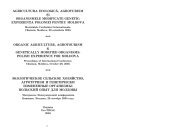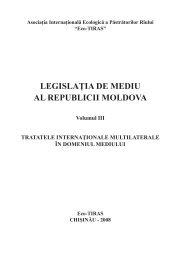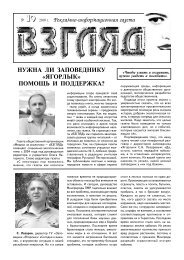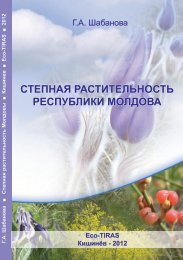2. Area is the most populated location within the U.S.portion of the Red River of the North Basin.3. Area has a long history of moderate to severeflooding; and4. The tool will be supported within the framework ofthe RRBDIN.Although the FMMA was selected, the tool is generaland transferable to other locations. This project hasresulted in the deployment of a working example of thetool using cutting-edge technology. A secondary benefitof the tool is understanding and demonstrating theimportance of and need for high-resolution topographicdata for hydrologic forecasting.Online productsThe following products are available through theRRBFFDT:User Interface – The RRBFFDT user interface isincorporated into the RRBDIN as a “tool.” The interfaceis an interactive map giving users the ability to navigate,turn on/off layers and query certain data layers. Themap interface includes a limited number of geo-spatiallayers including aerial imagery, parcel boundaries, cityboundaries, streets and roads, and hydrographic features.The application also allows users to search and zoom toan address from the address lookup tool.Map Products, Graphics and Animation – Variousmap products are available for display through the userinterface for the flood forecast period. The products areavailable for a 7-day period (“into the future”) basedupon the NWS forecast. Products include:• Flood Inundation Map – A map which shows theinundation area for a given date and time, based uponthe FLDWAV conditional forecast (FEMA, 2007). Themap uses colors / patterns to indicate: 1) areas protectedfrom flooding by a levee; 2) areas that flood as a result ofoverflow from the river; and 3) areas that flood becausewater ponds, rather than originates from the river.• Flood Inundation Animation Graphic – Animationshowing the flood inundation in 6 hour increments for aseven day forecast, based upon the FLDWAV conditionalforecast. The animation is controlled by the user with play,stop and rewind.• Maximum Flood Inundation Area Map – Map showingthe inundation area corresponding to the maximumelevation during the conditional forecast at each locationwithin the FFMA, based upon the FLDWAV conditionalforecast. This map is presented as a GeographicInformation System (GIS) layer which can be turned onand off by the user through the user interface.• Flood Peak Occurrence Map – Map showing themaximum elevations and the times of occurrence duringthe conditional forecast at specific locations (i.e., rivermiles). This map is presented as a GIS layer which can beturned on and off by the user through the user interface.• Critical Facilities Risk Map – Map portraying the riskof flooding critical facilities, including facilities associatedwith the flood response effort, public infrastructure andprivate infrastructure. Low, moderate and high risk levelsare represented using green, yellow and red color codingrespectively, of the facilities. This map is presented asa GIS layer which can be turned on and off by the userthrough the user interface.• Potential Road Flooding Map – Roads with thepotential to become inundate and flooded is inferredusing the Maximum Flood Inundation Area Map and thetransportation GIS layer. This requires the user to turn onthese layers using the map user interface.• Red River at Fargo Gage Static Maps – Thesemaps show the approximate area inundated based onpredetermined water levels at the U.S. Geological gagein Fargo (USGS, 2007) extrapolated upstream anddownstream. Stages, [elevations] for these maps arebased on the FEMA Flood Insurance Study (FIS) steadystate model analysis and does not incorporate anticipatedprecipitation, climate or measured snow conditions(FEMA 2000B). This product is fundamentally differentfrom those products based upon the NWS FLDWAVmodel, which is an actual forecast based on anticipatedprecipitation, climate, measured snow conditions, andunsteady hydraulic routing.• Sandbag Tool – The sandbag tool was developed asa proof of concept tool to demonstrate how organizationscould add tools to help them emergency management.The sandbag tool is meant as a proof on concept. Thesandbag tool is a selectable button on the map userinterface which allows the user to trace a line segment andobtain an estimate of the number of sandbags requiredfor protection (based on the need of 1 bag per linear footper foot of elevation with a maximum 5-foot height).• Communication Tools – Two tools are available toenhance communication with the user groups during aflood event.1. Flood Forecast E-mail Notification – Automatede-mail notification that the NWS is now forecasting andproducts are available through the RRBFFDT and atadditional NWS URLs.2. Really Simple Syndication (RSS) WeatherInformation – Live RSS stream of weather and othercritical emergency information presented as text on theFFDT home page.• Downloadable GIS Data – Users have the ability to<strong>download</strong> two types of GIS products for use on the localclient. Layers include:1. Flood Inundation Time Series – Contains a GISshapefile for each 6 hour increment in the seven dayconditional forecast.2. Maximum Flood Inundation Area Map – Containsa GIS shapefile for the maximum flood inundation area inthe conditional forecast.3. Flood Peak Occurrence Map – Contains a shapefilefor the locations of the flood peak occurrences and a textfile to join to the shapefile to obtain the arrival time of thepeak occurrence at each location.4. Depth Grid for Maximum Flood Inundation AreaMap – Contains an ESRI GRID for the maximum floodinundation area in the conditional forecast.5. Links – A set of link to the NWS “standard” floodforecast products.The RRBFFDT is intended to provide near real-timeflood forecast information to two user groups; i.e., the“general public” and the “public decision-maker.” TheGeneral Public user group consists of residents of andvisitors to the FMMA, whose daily activities are potentiallyaffected during a flood event. The information for publicdecision-makers is available only through a passwordprotected screen or domain name access. The PublicDecision-Maker user group consists of City administrativeand technical staff, Emergency Managers and EmergencyResponse personnel. Individuals comprising the Public— 259 —
Decision-Maker user group are responsible for someaspect of decision-making which is directly related to theirpublic role or responsibilities. All products are available tothis user group.ComparisionDuring development of the RRBFFDT the Project Teamcompleted a relative comparison of the area mapped asflooded by the tool using the NWS FLDWAV model resultsand a series of GIS inundation area files created by theU. S. Army Corp of Engineers, St. Paul District. The Teamcompared the results using the1997 flood for the FFMA.Limitations exist with each of the representations of theflood; i.e., aerial imagery and the mapping tool. Theselimitations include:1. The tool is intended to represent only those areasflooded as a result from overbank flow from the river orbackwater from a downstream river location.2. The aerial imagery captured areas with pondedwater. The source and reason for the ponded water maybe overbank flow from a river, inadequate drainage, orbackwater from a river.3. The GIS data developed by the Corps of Engineerscame from low-level aerial imagery, scanned and georeferenced,and then digitized.4. The tool maps only to the lateral extent of themapping cross-section.5. Break-out flows from the Sheyenne River, Wild RiceRiver and Rose Coulee create a complex flood mechanismwith the FMMA. This mechanism is not represented in theFLDWAV model results.6. Numerous permanent levees were constructedfollowing the 1997 flood event.Considering these limitations, the comparison yieldedreasonable results using the 1997 flood to evaluate performance.The comparison analysis consisted of determiningagreement for each 10-foot grid cell within the mapping extent.The comparison shows agreement between the aerialimagery and the tool nearly 80% of the time.Website useThe FMFFDT was launched the fall of 2007. Theregion experienced a moderate flood event in 2008, andmajor flood events in 2009, and 2010. The FFDT hasbeen widely used by residents in the Red River Basin.The website received over 149,000 hits in 2007 and justfewer than 1 million hits in 2009 and 2010.Citations1. Advanced Weather Information Interactive Processing System(AWIPS). 2007. “What is AWIPS.” http://fxa.noaa.gov/AWIPS.html.2. Federal Emergency Management Agency (FEMA). 2007.National Weather Service FLDWAV Computer Program. http://www.fema.gov/plan/prevent/fhm/dl_fdwv.shtm.3. Federal Emergency Management Agency (FEMA). 2007B. FEMAFlood Insurance Study. http://www.fema.gov/hazard/map/fis.shtm.4. National Oceanic and Atmospheric Administration (NOAA)National Weather Service. 2007. North Central River Forecast Center.http://www.crh.noaa.gov/ncrfc/.5. United States Geological Survey (USGS). 2007. North DakotaWater Science Center, 05054000 Red River of the North at Fargo, ND.http://nd.water.usgs.gov/floodtracking/charts/05054000_09020104.html.ИНСТРУМЕНТАРИЙ ВИЗУАЛИЗАЦИИ ПРОГНОЗА НАВОДНЕНИЙВ БАССЕЙНЕ РЕД-РИВЕР (Красной реки севера)Чарльз Фриц*, Марк Дойчман***Международный водный институт;**Корпорация Houston Engineering, USAВведениеИнструментарием визуализации прогноза наводненийв бассейне Ред-Ривер (ИВПНБРР) являетсяИнтернет-инструментарий, усиливающий возможностисуществующего вебсайта Информационнойсети для принятия решений в бассейне Ред-Ривер(ИСПРБРР) (http://www.rrbdin.org/) путем разработкиинтерактивного дисплея для визуализации прогнозанаводнений, разрабатываемого Национальной метеорологическойслужбой (НМС). Проект использует информациюо прогнозе наводнений, изданную Центромпрогнозирования режима северных рек Национальнойметеорологической службы в Чанхассене, Миннесоте,для создания интерактивных карт затопления при наводнениях;сетки глубин затоплений; графика, отображающегооценочное время прихода пика наводнения;и состояния стока внутри и за пределами Фарго,Северная Дакота – Мурхед, метрополия Миннесоты(ФММ). Методы и утилиты, разработанные для данногопроекта, могут быть переданы и в другие муниципальныеи сельские местности как самого бассейнаРед-Ривер, так и других мест США, поскольку предоставляютдостаточный объем цифровых данных о рельефеместности и информации по прогнозу. Переводстатьи на русский язык осуществлен Эко-ТИРАС.Обоснование проектаНациональная метеорологическая служба США(НМС) обычно издает прогнозы по уровню воды в определенныхточках вдоль Ред-Ривер Севера во времянаводнений (NOAA, 2007). Несмотря на то, чтоданные прогнозов чрезвычайно полезны, интерпре-— 260 —
- Page 3 and 4:
Descrierea CIP a Camerei Nationale
- Page 5 and 6:
Уважаемые коллеги,
- Page 7 and 8:
щегосударственной
- Page 9 and 10:
доме, в котором мы в
- Page 11 and 12:
шие глубины на заде
- Page 13 and 14:
с малыми восстанов
- Page 15 and 16:
Литература1. Жадин
- Page 17 and 18:
Рис. 3. Многолетняя
- Page 19 and 20:
тера и глубины изме
- Page 21 and 22:
ПОДДЕРЖАНИЕ БИОРАЗ
- Page 23 and 24:
Таблица 5. Оптималь
- Page 25 and 26:
Таблица. Результат
- Page 27 and 28:
ФОРМИРОВАНИЕ БИОЦЕ
- Page 29 and 30:
Подавляющее больши
- Page 31 and 32:
Рис.1. Днестр вблизи
- Page 33 and 34:
сопоставимости дан
- Page 35 and 36:
ции с международны
- Page 37 and 38:
А.Н. Бургеля, К.П. Бу
- Page 39 and 40:
Выводы1. Уже на само
- Page 41 and 42:
тегории, виды и пор
- Page 43 and 44:
санитарно-эпидемио
- Page 45 and 46:
Таблица 4. Распреде
- Page 47 and 48:
реационных, монито
- Page 49 and 50:
Шабановой Г.А. и Кух
- Page 51 and 52:
могут быть убраны,
- Page 53 and 54:
Турунчук. Связь с с
- Page 55 and 56:
Праздник «День Рек
- Page 57 and 58:
500ЈPРис. Распределе
- Page 59 and 60:
Н. Гроссу * , Р. Шакир
- Page 61 and 62:
Рис.1. Помесячное ра
- Page 63 and 64:
Calitatea apei r. Nistru conform gr
- Page 65 and 66:
Карта геохимическо
- Page 67 and 68:
лесу был дуб, сегод
- Page 69 and 70:
При предварительно
- Page 71 and 72:
щих улучшить социа
- Page 73 and 74:
ней опасных загряз
- Page 75 and 76:
ФотоприложениеФот
- Page 77 and 78:
в Украине - одесска
- Page 79 and 80:
тия по гидрохимиче
- Page 81 and 82:
ветствующих санита
- Page 83 and 84:
ния полей, так и для
- Page 85 and 86:
В. Экономический ан
- Page 87 and 88:
Таким образом, плат
- Page 89 and 90:
Рис. 2. Динамика нор
- Page 91 and 92:
Табл. 1а. Статистиче
- Page 93 and 94:
Выводы1. Наибольшее
- Page 95 and 96:
Для днестровской в
- Page 97 and 98:
ЭКОЭТИЧЕСКОЕ ВОСПИ
- Page 99 and 100:
Таблица 1. Валовое с
- Page 101 and 102:
почвенный покров п
- Page 103 and 104:
always been the public concern of b
- Page 105 and 106:
и уникальными по си
- Page 107 and 108:
ются основными фак
- Page 109 and 110:
Рис. 4. Пораженность
- Page 111 and 112:
ight to use”. Varone et al. (2002
- Page 113 and 114:
mass media, etc., which belong to d
- Page 115 and 116:
В связи с тем, что К
- Page 117 and 118:
период поездки вых
- Page 119 and 120:
doutchinae (d’Orb.), выше з
- Page 121 and 122:
вместе с осадками в
- Page 123 and 124:
Таблица 4. Содержан
- Page 125 and 126:
efectuat în baza următorilor indi
- Page 127 and 128:
видуальных различи
- Page 129 and 130:
- соответствующее з
- Page 131 and 132:
ФАУНА КЛЕЩЕЙ ДРЕВЕ
- Page 133 and 134:
Таблица 1. Данные ра
- Page 135 and 136:
РЕКРЕАЦИОННЫЕ РЕСУ
- Page 137 and 138:
ЭТАПЫ ЭВОЛЮЦИИ БИО
- Page 139 and 140:
Плотина Дубоссарск
- Page 141 and 142:
чимые. При этом «пе
- Page 143 and 144:
Схематически получ
- Page 145 and 146:
Таблица 5. Данные на
- Page 147 and 148:
Risks for biodiversity with tested
- Page 149 and 150:
14. Ярошенко M.Ф., Дед
- Page 151 and 152:
20082009Fig. 2. Structure of shrew
- Page 153 and 154:
с природой (различн
- Page 155 and 156:
делить в их предела
- Page 157 and 158:
Таблица. Оценка эне
- Page 159 and 160:
лах Приднестровья
- Page 161 and 162:
ВыводыКраеведческ
- Page 163 and 164:
вий среды жизнедея
- Page 165 and 166:
Senecio besserianus Minder. Cypripe
- Page 167 and 168:
Рис.1. Почвенная кар
- Page 169 and 170:
половины площади п
- Page 171 and 172:
Рис. 2. Современное
- Page 173 and 174:
ПРИЧИНЫ ГЕОМОРФОЛО
- Page 175 and 176:
RÂURILE MICI CU ŞANSE MARIDE A FI
- Page 177 and 178:
ЭКОНОМИКО-ЭКОЛОГИЧ
- Page 179 and 180:
прибрежной зоной (п
- Page 181 and 182:
Строительство в пр
- Page 183 and 184:
государственного у
- Page 185 and 186:
ческий, социальный
- Page 187 and 188:
ми, послужило весом
- Page 189 and 190:
губительно влияющи
- Page 191 and 192:
ных за контролем и
- Page 193 and 194:
PECULARITIES OF DYNAMICS OF PHOSPHO
- Page 195 and 196:
Fig. 4. Spatial and seasonal dynami
- Page 197 and 198:
• inventory of point discharges s
- Page 199 and 200:
СТЕРИЛИЗАЦИЯ КАК С
- Page 201 and 202:
гормоны (в незначит
- Page 203 and 204:
ПРОТОКОЛ ПО ПРОБЛЕ
- Page 205 and 206:
воды ежегодно умир
- Page 207 and 208:
РАЗРАБОТКА ПЛАНОВ
- Page 209 and 210: ставляет материаль
- Page 211 and 212: • Совершенствован
- Page 213 and 214: «Алые паруса». Таки
- Page 215 and 216: which the Committee is then require
- Page 217 and 218: нием, культурой и х
- Page 219 and 220: - Николаевская церк
- Page 221 and 222: Сброшенный на 50 м б
- Page 223 and 224: СТРУКТУРА ГЕОИНФОР
- Page 225 and 226: 4. Пространственная
- Page 227 and 228: На фазе пика числен
- Page 229 and 230: А.А. Тищенков, В.В. М
- Page 231 and 232: Распределение видо
- Page 233 and 234: цветковый (ККП, ЧКУ,
- Page 235 and 236: очередной задачей
- Page 237 and 238: схемой планировани
- Page 239 and 240: эксплуатационным п
- Page 241 and 242: ных дамб, с возвращ
- Page 243 and 244: ледствия от урбани
- Page 245 and 246: ОСНОВНЫЕ ФОРМЫ ДЕГ
- Page 247 and 248: УЧАСТИЕ НЕПРАВИТЕЛ
- Page 249 and 250: струкции как от сбр
- Page 251 and 252: Рогоз широколистны
- Page 253 and 254: Таблица 3. Изменени
- Page 255 and 256: В рамках первых тре
- Page 257 and 258: Основные экскурсио
- Page 259: 2. Кравченко Е.Н. При
- Page 263 and 264: может ее запускать,
- Page 265 and 266: поражения населени
- Page 267 and 268: тию РДЮЦ «ГУТТА - кл
- Page 269 and 270: мость разработки н
- Page 271 and 272: Биология. Подорожн
- Page 273 and 274: банизированных тер
- Page 275 and 276: Результаты исследо
- Page 277 and 278: площадь ассимиляци
- Page 279 and 280: Рис. 3. Дендрограмма
- Page 281 and 282: Рис.1. Сезонная дина
- Page 283 and 284: Молдовы и Приднест
- Page 285 and 286: Ребята приехали в 10
- Page 287 and 288: Рис. 1. Численность
- Page 289 and 290: жений, в том числе э
- Page 291 and 292: [4]. Несомненно, выжи
- Page 293 and 294: КОНСТИТУЦИОНАЛЬНА
- Page 295 and 296: В настоящее время б
- Page 297 and 298: 8. Суворцева В.Ю., Ру
- Page 299 and 300: Окончание табл. 2Ок
- Page 301 and 302: содержаниеПРЕДИСЛ
- Page 303 and 304: А.П. Погребняк, В.Ф.
- Page 305: Научное изданиеБАС


![[download]13,2 Mb - Eco - Tiras](https://img.yumpu.com/50284532/260/500x640/download132-mb-eco-tiras.jpg)













